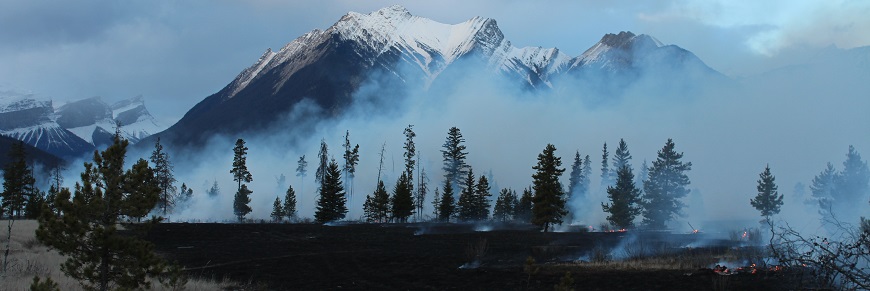
Common nighthawk
Jasper National Park
Quick facts
Eats flying insects
Lays 2 eggs once or twice per year
Nests on the ground and gravel roofs
Sounds like a buzzy nasal “peent”
SARA status: Threatened (2010)
COSEWIC recommended status: Special concern (2018)

Common nighthawks (Chordeiles minor) are masters of camouflage. Their speckled bodies make them virtually impossible to see when they are perched on the ground. They are one of the few birds that lay their eggs directly on bare soil, gravel or rock.
These birds hunt at dawn and dusk. They dart around on their narrow pointed wings and use their excellent night vision to snap up flying insects. They mostly eat beetles, caddisflies and moths. Nighthawks can be identified by their erratic flight and narrow pointed wings with a white bar. If you hear a buzzy nasal “peent”, look up and you’ll see this bird chasing insects overhead. When it dives, air rushes through its wing feathers and makes a “bruum” sound.
Where they live
The common nighthawk travels thousands of kilometres each year, flying from summer breeding grounds in North America to wintering grounds in Central or South America.It makes one of the longest north-south migrations of any bird species in North America.
Common nighthawks like open forests and grasslands with lots of flying insects. They breed in Jasper National Park, but it is rare to see them. They are most often seen during migration and in grasslands.

Common nighthawks nest on the ground in grasslands in Jasper National Park. Grasslands are declining across Canada and are one of the rarest habitat types in the park. We use prescribed fire to help restore grasslands like this one near the Athabasca River.
Why they are at risk
Migratory birds that eat flying insects have significantly declined around the world since the 1970s. The cause of this decline is likely the combined effects of many factors, including declining insect populations, habitat loss, and climate change.
The Committee on the Status of Endangered Wildlife in Canada has recommended the common nighthawk be listed as a species of Special Concern because the rate of decline has slowed and the species appears to have stabilized in areas with good habitat.
Flying insect declines
The global decline in flying insects is not well understood. Some possible reasons include: 1) the use of pesticides – which are chemicals used to control weeds, insects and fungus, 2) methods used to boost agricultural production that affect soil and water sources, 3) extreme weather events, 4) destruction of wetlands and 5) the warming climate. Less bugs means less food for migratory birds.
Climate change
Climate change may affect the common nighthawk, its habitat and its migration routes in many ways. Changes to the patterns and severity of extreme weather events like fires, droughts and hurricanes all have the potential to impact the common nighthawk and the availability of its insect prey.
Human development and activity
For decades, humans have put out wildfires, causing open grasslands to become overgrown and forested.
Habitat loss can affect the common nighthawk in their nesting grounds, wintering grounds and anywhere along their migratory routes.
Off-leash dogs and foot traffic can easily disturb them. Household cats also prey on the chicks.
How we are helping
Protecting nesting sites
We prevent nesting sites from being disturbed by putting up signs that encourage people to stay on official trails.
Dogs must be kept on-leash in national parks. One of the reasons to keep pets on leashes is to prevent them from disturbing ground nesting birds.
Monitoring
We set up audio recording stations in common nighthawk habitats and program them to record audio at night when the birds are most active.
We monitor the bird sighting database at ebird.org. Share your sightings to contribute to this citizen science project.
Restoring fire
The common nighthawk depends on open areas for breeding and hunting insects. We use prescribed fires to restore open grassland habitats.

Restoring grasslands with prescribed fire in the Athabasca Valley in 2021.
How you can help
Keep your dog on a leash at all times while you visit national parks and protect ground nesting birds like common nighthawk.
Learn more
- Date modified :